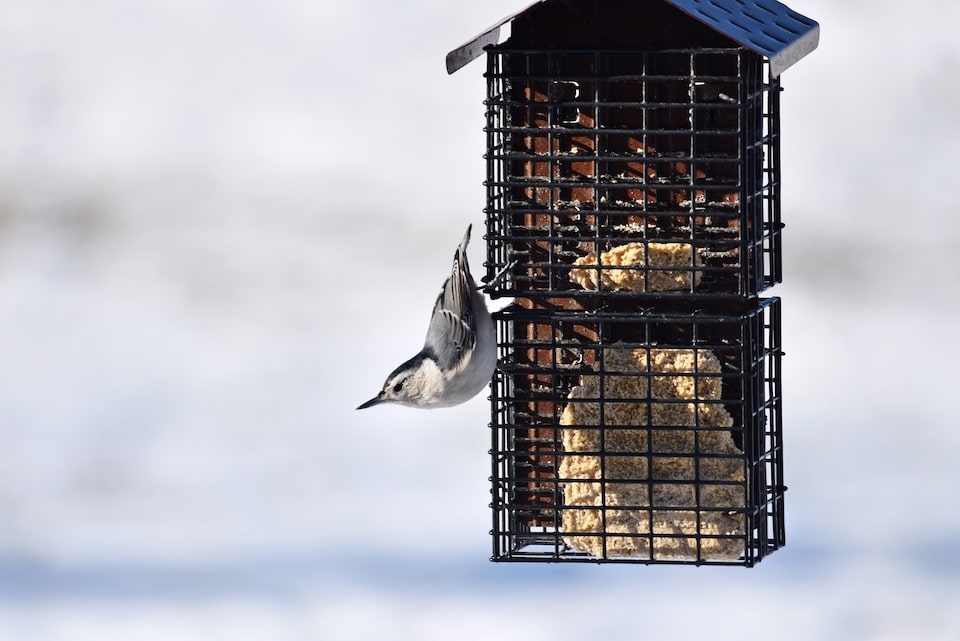Find out why Craig Springer, USFWS, Office of Conservation Investment, considers birding both a balm and a benison.
Some years back I put up nest boxes in my woodlot for the cavity-nesting birds. White-breasted nuthatches readily took to the boxes for raising broods, and for roosting.
As our planet makes its autumnal tilt, a whole host of songbirds and raptors head south for warmer climes. But the woods are not vacant. The nuthatches live here year-round sharing the pinyons with mountain chickadee and juniper titmouse.

You can hear a fuzzy chicka-dee-dee or the chirpy and serried whickity-whickty-whickity that arcs through the air like sparks off hot steel. A lot of sound comes out of a little titmouse. The nasally yank-yank of a white-breasted nuthatch lacks musical quality, and even when it sings close by it sounds as though it is far away.
Winter birds are a benison—a reward unto themselves. All birds offer a connection to nature that comes to us both active and passive, on birding safaris, waterfowl hunting, trailing a bird dog after prairie grouse, or glances at a feeder out the living room window.
“Birds are accessible—nearly always with us no matter where we are—town or country,” said Matt Hogan, the U.S. Fish and Wildlife Service’s Mountain-Prairie Regional Director. “A connection to nature is demonstrably good for body, mind and soul and birding is one way there.”
A robust number of birders exist in the United States. An addendum to the 2022 National Survey of Fishing, Hunting, and Wildlife-Associated Recreation (Survey) reveals that a great number of people take part in birding, be it at home or beyond their residence. They spend in the aggregate, quite a large sum of money.
U.S. Fish and Wildlife Service economist, Erin Carver, waded deeply into demographic and economic data collected for the Survey. She ferreted out telling details about birders and their expenditures. The data will be of interest to those in industry, tourism, wildlife managers, researchers, and planners.
Here’s a snapshot of what you will find in Birding in the United States: A Demographic and Economic Analysis:
-Nearly 96 million people aged 16 and older are birders in the United States.
-The average age of birders is 49 years, with the majority age 65 and older.
-Ninety-one million people watch birds around their home.
-Participation in birding between men and women is nearly equal.
-Twenty-four percent of birders fish; a separate 8 percent of birders hunt; and 6 percent of birders both fish and hunt.
-Male birders are more likely to also fish and hunt.
-African American birders tend to fish and hunt more than other races.
-Birders spent $107.6 billion on trips and equipment, with cameras, nest boxes, bird food and more accounting for $12.6 billion of that total.
“No doubt about it, birding is important to the American people,” said Hogan, himself an avid birder and bird hunter. “Watching birds lightens your heart—it lifts your soul like friendly smiles and pleasantries exchanged between strangers. The positive influence of birding on the American economy and jobs is hefty, encouraging—and appreciated. Birding and wildlife-related pursuits also have immeasurable aesthetic and intrinsic value.”
Just what is the value of watching a nuthatch walking head-first down a tree trunk defying gravity, looking more like a horsefly than a bird. The slate-blue and white bird will take pause, give you a sideways quizzical glance over its spikey beak and be off. But it’s not going far.
To read Birding in the United States: An Economic and Demographic Analysis, click here. For more information on the Survey and other addenda, click here.
The Survey and its addenda are funded by a Multistate Conservation Grant, dollars first derived from Pittman-Robertson and Dingell-Johnson Acts, and federal excise taxes paid by manufacturers of fishing tackle, archery gear, firearms, ammunition, and motorboat fuels.
The Women's Outdoor News, aka The WON, features news, reviews and stories about women who are shooting, hunting, fishing and actively engaging in outdoor adventure. This publication is for women, by women. View all posts by The WON